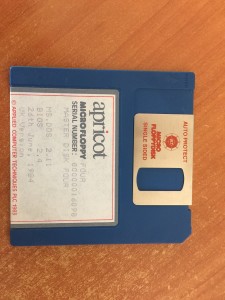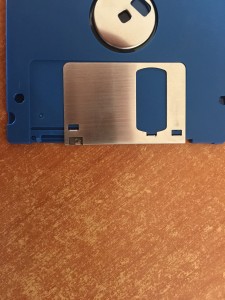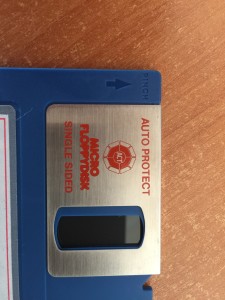I was talking on IRC to some people today about an old Apricot computer I had, which had some curious features. Among other things, it was PC compatible in all ways except the BIOS, which meant that it needed a special custom version of MSDOS to boot. I remembered, while thinking about this, that I had some unusual very early floppy disks that had come with it. These don’t quite look like your normal 3.5″ floppies, although they’re compatible with normal drives.
 Unlike normal floppy disks, these ones have a latching shutter that can be held open. As far as I can tell, this was so that drives could be made without the extra arm/lever that flicks open the shutter, and therefore would reduce costs a little bit. For some reason I’ve never seen this style of disk anywhere else, so I thought I should photograph one of the ones I’ve got for posterity’s sake.
Unlike normal floppy disks, these ones have a latching shutter that can be held open. As far as I can tell, this was so that drives could be made without the extra arm/lever that flicks open the shutter, and therefore would reduce costs a little bit. For some reason I’ve never seen this style of disk anywhere else, so I thought I should photograph one of the ones I’ve got for posterity’s sake.
The latch itself is simply made from the plastic of the disk and an extra crease in the metal shutter blades. To latch the shutter open, you just push it open past the normal stop point where a normal floppy drive would push it to; beyond that point, it locks into place. To release it, you just squeeze the corner of the disk, which is slightly split, and the shutter pops closed again.
This also makes it a little easier to clean the disk surface if you manage to get some greasy finger-prints onto it somehow (although it obviously increases the possibility of that happening in the first place). I can only suppose that these were really early disks and predated the lever being standard in floppy drives, but I was sure that Sony invented the 3.5″ microfloppy, and that the first ones had that lever. Perhaps some clones omitted that detail for some reason? In any case, it’s an interesting and rare feature.
The same company supplied, at the same time, some disks without this feature too, and my Apricot machine didn’t actually need the latch, just to further confuse matters.





Nice article.
You might want to revise it to reflect what is posted about the original Sony design at Wikipedia talk (where u linked to this article). Apricot and others used the original Sony design, The shutter acted like the sleeve in the larger FDs, better in fact since it was attached. So that is more likely the reason for this construction than saving a few parts. The self closing shutter was one of the several design changes forced by the MIC
I would like from the Wikipedia article to this one if it was more complete and less speculation.
I don’t think the wikipedia discussion has managed to get quite the right situation either; the Apricot drives were Sony parts, right enough, but they work fine with the normal spring-loaded shutters on the red disk that you can see above, so they clearly didn’t absolutely depend on the shutter latching.
It appears that the blue Apricot disks have shutters that are some sort of compromise, as the shutter is spring loaded, but can be locked into place by pushing it past the normal opening extent – it’s not unsprung entirely, as people have described the Sony format on wikipedia, which sounds like it doesn’t match either the MIC or Sony specifications.
Presumably there must have been some drives that depended on the latch, but the mixture of disk types I have suggests that this didn’t happen for this particular model of Apricot, as the red disk would not be functional in it had they demanded the latch.